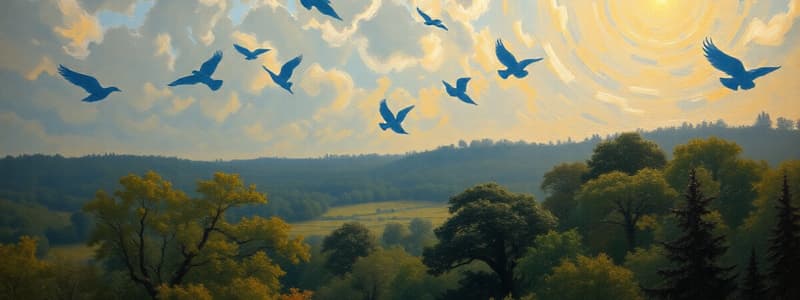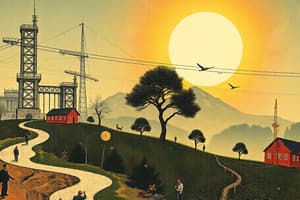Podcast
Questions and Answers
Explain how an increase in atmospheric carbon dioxide concentration can lead to ocean acidification and describe one potential consequence for marine life.
Explain how an increase in atmospheric carbon dioxide concentration can lead to ocean acidification and describe one potential consequence for marine life.
Increased atmospheric CO2 dissolves in the ocean, forming carbonic acid, which lowers the ocean's pH. This acidification can hinder the ability of shellfish and corals to build and maintain their calcium carbonate shells and skeletons.
Describe how deforestation contributes to climate change, naming at least two specific mechanisms.
Describe how deforestation contributes to climate change, naming at least two specific mechanisms.
Deforestation reduces the number of trees available to absorb CO2 from the atmosphere through photosynthesis. Burning trees during deforestation also releases stored carbon directly into the atmosphere, acting as a positive feedback loop.
Outline the difference between climate and weather, and provide an example illustrating this difference.
Outline the difference between climate and weather, and provide an example illustrating this difference.
Weather refers to short-term atmospheric conditions at a specific time and place, while climate describes long-term patterns of weather in a region. For example, a blizzard is weather, while the average winter temperature in Canada is climate.
Describe how melting permafrost contributes to a positive feedback loop in climate change.
Describe how melting permafrost contributes to a positive feedback loop in climate change.
Explain how changes in land use, such as urbanization, can impact local temperatures and precipitation patterns.
Explain how changes in land use, such as urbanization, can impact local temperatures and precipitation patterns.
What are climate models, and why are they important for understanding future climate change scenarios?
What are climate models, and why are they important for understanding future climate change scenarios?
Briefly describe the concept of radiative forcing and how it relates to greenhouse gases.
Briefly describe the concept of radiative forcing and how it relates to greenhouse gases.
Explain how ice cores can provide historical data about Earth's climate.
Explain how ice cores can provide historical data about Earth's climate.
How does the concept of albedo relate to climate change, and what are two examples of surfaces with contrasting albedo?
How does the concept of albedo relate to climate change, and what are two examples of surfaces with contrasting albedo?
Describe the difference between climate change mitigation and climate change adaptation, and provide one example of each.
Describe the difference between climate change mitigation and climate change adaptation, and provide one example of each.
Explain how changes in ocean currents, such as the Gulf Stream, could impact regional climates.
Explain how changes in ocean currents, such as the Gulf Stream, could impact regional climates.
Describe the role of the Intergovernmental Panel on Climate Change (IPCC) in addressing climate change.
Describe the role of the Intergovernmental Panel on Climate Change (IPCC) in addressing climate change.
What is a carbon footprint, and what are two actions individuals can take to reduce their carbon footprint?
What is a carbon footprint, and what are two actions individuals can take to reduce their carbon footprint?
Describe the concept of 'tipping points' in the context of climate change, and provide one potential example.
Describe the concept of 'tipping points' in the context of climate change, and provide one potential example.
How do aerosols in the atmosphere affect climate, and what are two examples of aerosols?
How do aerosols in the atmosphere affect climate, and what are two examples of aerosols?
What is the 'greenhouse effect,' and how does it naturally regulate Earth's temperature?
What is the 'greenhouse effect,' and how does it naturally regulate Earth's temperature?
How can changes in agricultural practices contribute to either mitigating or exacerbating climate change?
How can changes in agricultural practices contribute to either mitigating or exacerbating climate change?
Explain the concept of carbon sequestration and provide one example of a natural carbon sink.
Explain the concept of carbon sequestration and provide one example of a natural carbon sink.
Define the term 'sea-level rise' and describe two factors that contribute to it.
Define the term 'sea-level rise' and describe two factors that contribute to it.
Describe the Kyoto Protocol and the Paris Agreement. What are the main goals of each?
Describe the Kyoto Protocol and the Paris Agreement. What are the main goals of each?
Flashcards
Ocean Acidification Cause & Consequence
Ocean Acidification Cause & Consequence
Increased atmospheric CO2 dissolves in the ocean, forming carbonic acid, which lowers the ocean's pH. This acidification can hinder the ability of shellfish and corals to build and maintain their calcium carbonate shells and skeletons.
Deforestation's Impact on Climate
Deforestation's Impact on Climate
Deforestation reduces CO2 absorption and releases stored carbon, increasing atmospheric greenhouse gases.
Climate vs. Weather
Climate vs. Weather
Weather: short-term atmospheric conditions; Climate: long-term weather patterns. Ex: Blizzard (weather) vs. average winter temperature (climate).
Permafrost Feedback Loop
Permafrost Feedback Loop
Signup and view all the flashcards
Urbanization Effects on Climate
Urbanization Effects on Climate
Signup and view all the flashcards
Climate Models
Climate Models
Signup and view all the flashcards
Radiative Forcing
Radiative Forcing
Signup and view all the flashcards
Ice Core Data
Ice Core Data
Signup and view all the flashcards
Albedo Effect
Albedo Effect
Signup and view all the flashcards
Mitigation vs. Adaptation
Mitigation vs. Adaptation
Signup and view all the flashcards
Ocean Current Impacts
Ocean Current Impacts
Signup and view all the flashcards
Reducing Carbon Footprint
Reducing Carbon Footprint
Signup and view all the flashcards
Climate Tipping Points
Climate Tipping Points
Signup and view all the flashcards
Greenhouse Effect
Greenhouse Effect
Signup and view all the flashcards
Agriculture and Climate Change
Agriculture and Climate Change
Signup and view all the flashcards
Carbon Sequestration
Carbon Sequestration
Signup and view all the flashcards
Sea-Level Rise
Sea-Level Rise
Signup and view all the flashcards
Paris Agreement
Paris Agreement
Signup and view all the flashcards



